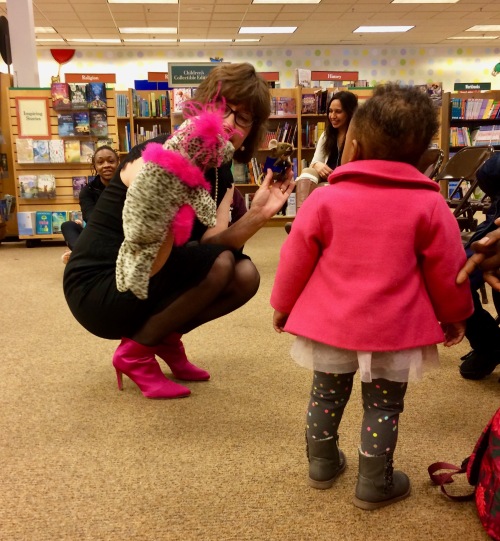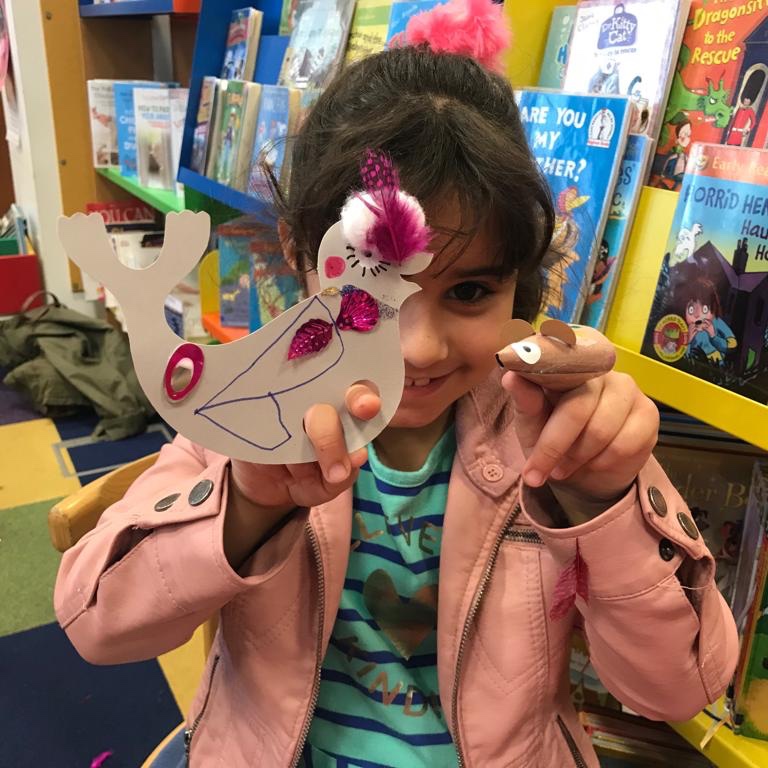Over the years, I’ve discovered that something extra magical happens when I add puppets to my story times. The kids love it! Interested in giving puppets a try? Here are ten tips to get you started.
Before the story time.
1. Pick a puppet that fits the book. The puppet you choose can either be a protagonist, like my seal, mouse and owl, or minor characters such as my skunks, rooster, or my newest mouse. The most important thing is that you have a good reason for picking that puppet – a reason that enhances your story time. For example, the skunks are useful in introducing an important and fun subplot in GOODNIGHT, ARK. (They are hiding under the bed in every spread until – at last – they make a big stink that’s important to the resolution of the story.) And that rooster, while very minor to GOODNIGHT, MANGER, becomes a fun and engaging way to introduce the concept of loud vs. quiet voices when putting a baby to bed.

2. Play… and plan ahead of time! This is probably obvious, but it’s worth spending time in advance putting together a little stand-up routine for you and your puppet. This is your chance to tap into your inner comedian. The more you ham it up, the more the kids will love it!
3. Practice your ventriloquist skills. There are two ways to use your puppet. Either you can just talk with it and it can shyly nod, react etc., OR you can have that puppet actually converse with you, or “cock-a-doodle-doo” as my rooster does and SING as that darling Diva Delores loves to do! If you decide to have them speak, then I’d recommend practicing your ventriloquist skills in front of a mirror ahead of time.
During the story time.
4. Use your puppets to break the ice. If you are a little shy, like me, then you’ll probably agree that mingling is easier with a buddy. In that awkward “before the story time officially begins” period, I’ve discovered that EVERYBODY enjoys a little mingling with the author and her storytelling companion – especially when it’s a cute stuffed animal puppet.
5. Have your puppets help introduce the story. This takes a little planning ahead of time (see step 2), but a short puppet routine is a great way to introduce the themes of your story, any special concepts, or just to get the kids excited. For DIVA DELORES, for example, my seal puppet likes to sing for the audience so they can hear what opera sounds like. Then she invites them to join along in singing the refrain that appears on certain spreads in the book. And Mouse, my storytelling companion for HAPPY BIRTHDAY CHRISTMAS CHILD, will introduce littlest ones to the concept of counting and birthdays! We might even play a fun counting game during that “break the ice” time.

6. Have the children model for the puppets what “good listening” looks like before you read. It’s amazing how eager young readers are to engage with the puppets, and I’ve discovered over time that little ones especially like the opportunity to model for my puppets what good listeners look like. So, I have THEM show the puppets what it looks like to sit quietly with eyes on reader, ready to be read to.
7. Use your puppets to engage young readers in some post-reading ponderings. After my readings, I like for the kids to reflect with me on what the characters in the story learned and I’ve found that involving the puppets in the process is effective and popular. For example, after reading GOODNIGHT, MANGER we ponder what made the difference in getting Baby Jesus to sleep. (The answer has to do with creating a quiet, peaceful atmosphere). Then, together, we see if we can teach our very NOISY rooster to do a quiet cock-a-doodle-doo. If he learns well, we invite him to join as we sing a final lullaby to Baby Jesus. For LOVE IS KIND, Little Owl helps me select volunteers to share their post-reading thoughts on how they, too, can be kind.
8. Include your puppets in the story time farewell. This can be very motivational if your audience is getting antsy because you can promise your young participants that if they hold on just a little longer, then they can pet and hug the visiting puppet! They love this! And I am just charmed by how many “I love yous” each puppet has so gently received over the last eight years since I first started using puppets.
After the story time.
9. Have a puppet de-briefing session with yourself. After each story time, I find it helpful to evaluate what worked, what didn’t, and what I could do next time to make that puppet even more integral to my story time. For example, it wasn’t until I had done a few story times in that I decided to have my GOODNIGHT, ARK skunk puppets engage my audience in a little quiet “thumbs up” challenge. But it worked so well, that now, at every GOODNIGHT, ARK story time, my skunk puppets challenge the audience to quietly put “thumbs up” as soon as they spot the skunks on each spread – which makes for a nice set up to the stinky climax!
10. Most important: HAVE FUN! Yes, let’s not forget this last important tip. If you are having fun, it will be contagious!
Note: If you enjoyed this post, please consider subscribing to my blog using the subscribe button in the footer or sidebar. I post once or twice weekly with inspirational reflections, tips, interviews and more.
























 She cut 40 templates for both characters, snipped 40 woolly mouse tails, punched 80 mouse ears, and dotted 120 sticky eyes ahead of the event.
She cut 40 templates for both characters, snipped 40 woolly mouse tails, punched 80 mouse ears, and dotted 120 sticky eyes ahead of the event.


 It was such a smash that when the templates ran out a half hour before the end of the workshop the resourceful kiddos stayed to make cute characters out of the cotton wool balls meant for Delores’ wigs!
It was such a smash that when the templates ran out a half hour before the end of the workshop the resourceful kiddos stayed to make cute characters out of the cotton wool balls meant for Delores’ wigs! Today I am delighted to be guest blogging over at picture book author and librarian Lauri Fortino’s blog on one of my favorite topics:
Today I am delighted to be guest blogging over at picture book author and librarian Lauri Fortino’s blog on one of my favorite topics: 